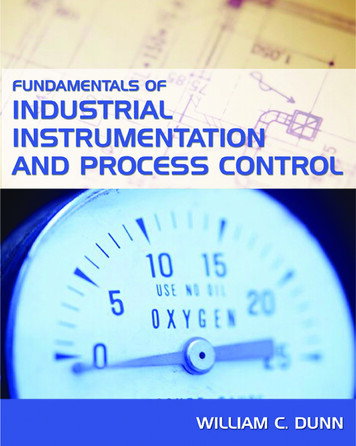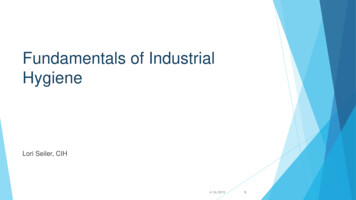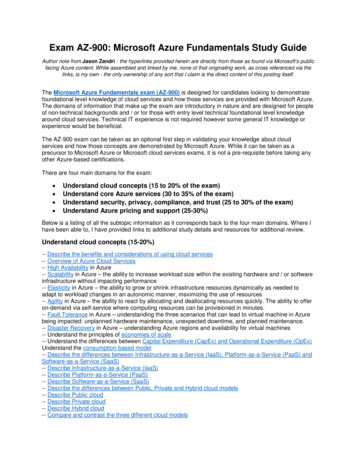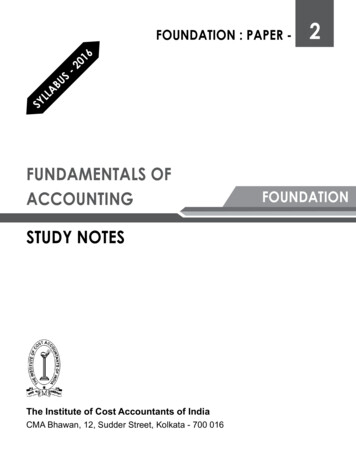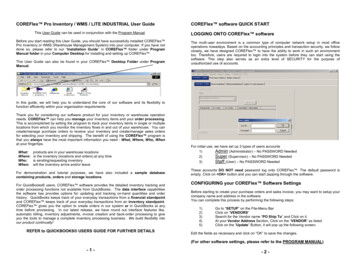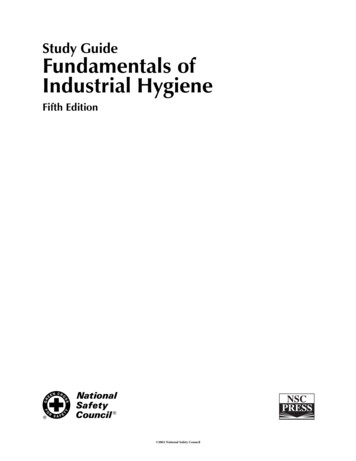
Transcription
Study GuideFundamentals ofIndustrial HygieneFifth EditionRR 2002 National Safety Council
NATIONAL SAFETY COUNCIL MISSION STATEMENTThe mission of the National Safety Council is to educate and influence society to adoptsafety, health, and environmental policies, practices, and procedures that prevent and mitigate human suffering and economic losses arising from preventable causes.COPYRIGHT, WAIVER OF FIRST SALE DOCTRINEThe National Safety Council's materials are fully protected by the United States copyrightlaws and are solely for the noncommercial, internal use of the purchaser. Without the priorwritten consent of the National Safety Council, purchaser agrees that such materials shallnot be rented, leased, loaned, sold, transferred, assigned, broadcast in any media form,publicly exhibited or used outside the organization of the purchaser, or reproduced, storedin a retrieval system, or transmitted in any form or by any means, electronic, mechanical,photocopying, recording or otherwise. Use of these materials for training for which compensation is received is prohibited, unless authorized by the National Safety Council inwriting.DISCLAIMERAlthough the information and recommendations contained in this publication have beencompiled from sources believed to be reliable, the National Safety Council makes no guarantee as to, and assumes no responsibility for, the correctness, sufficiency, or completenessof such information or recommendations. Other or additional safety measures may berequired under particular circumstancesCopyright 2002 by the National Safety CouncilAll Rights ReservedPrinted in the United States of America06 05 04 03 021 2 3 4 5ISBN: 0-87912-236-65C0302Product Number: 15107-0000 2002 National Safety Council
Contents1 Overview of Industrial Hygiene12 The Lungs133 The Skin and Occupational Dermatoses234 The Ears355 The Eyes476 Industrial Toxicology577 Gases, Vapors, and Solvents678 Particulates779 Industrial Noise8710 Ionizing Radiation9711 Nonionizing Radiation11312 Thermal Stress12313 Ergonomics13314 Biological Hazards14515 Evaluation157iii 2002 National Safety Council
16 Air Sampling16917 Direct-Reading Instruments for Gases,Vapors, and Particulates18118 Methods of Control18919 Local Exhaust Ventilation20120 Dilution Ventilation of Industrial Workplaces21321 General Ventilation of Nonindustrial Occupancies21922 Respiratory Protection23123 The Industrial Hygienist24324 The Safety Professional25125 The Occupational Medicine Physician26326 The Occupational Health Nurse26927 The Industrial Hygiene Program27728 Government Regulations28929 History of the Federal Occupational Safety andHealth Administration299iv 2002 National Safety Council
1Overview of Industrial HygieneQuiz 1 (25 total points)True/False (7 points)1. Environmental stress has no effect on the aging process.a. trueb. false2. The first vital component to an effective health and safety program is the commitment ofsenior management and line management.a. trueb. false3. It is possible that the responsibilities of a safety professional and an industrial hygienist canbe found in the same person.a. trueb. false4. In many cases it is extremely difficult to differentiate between the symptoms of occupational and nonoccupational disease.a. trueb. false5. The majority of occupational health hazards arise from living organisms that can causeadverse responses in humans.a. trueb. false1 2002 National Safety Council
Study Guide: Fundamentals of Industrial Hygiene6. Solvent vapors enter the body mainly by skin absorption, although some inhalation canoccur.a. trueb. false7. Storage of dangerous chemicals should be limited to one week’s supply.a. trueb. falseMultiple Choice (8 points)8. The must draw upon specialized knowledge in the physical and social sciences,including knowledge of engineering, physics, chemistry, statistics, mathematics, and principles of measurement and analysis.a. senior managerb. safety professionalc. line managerd. occupational medicine physician9. The provides the critical link between the employee’s health status, the work process,and the determination of employee ability to do the job.a. occupational health nurseb. line managerc. occupational medicine physiciand. employee10. The primary goal of the is to prevent occupational illness and, when illness occurs, torestore employee health within the context of a healthy and safe workplace.a. line managerb. occupational medicine physicianc. occupational health nursed. safety professional11. Joint labor-management safety and health committees are often used where employees arerepresented by a .a. lawyerb. agentc. uniond. senior manager2 2002 National Safety Council
1 Overview of Industrial Hygiene12. In what year did the Occupational Safety and Health Administration (OSHA) come intoofficial existence?a. 1969b. 1970c. 1971d. 197213. What is the principle federal agency engaged in occupational health and safety research?a. Occupational Safety and Health Administrationb. National Institute for Occupational Safety and Healthc. American Academy of Industrial Hygiened. American Conference of Governmental Industrial Hygienists14. are capable of destroying living tissue and have a destructive effect on other substances, particularly on combustible materials.a. Explosivesb. Toxic chemicalsc. Corrosivesd. Oxidizing materials15. are chemicals that decompose rapidly under certain conditions to yield oxygen.a. Explosivesb. Oxidizing materialsc. Corrosivesd. Dangerous gasesShort Answer (8 points)16. Define industrial hygiene.17. In late 1994, four major U.S. industrial hygiene organizations gave final endorsements to arevised Code of Ethics for the Practice of Industrial Hygiene. Name these four organizations.18. Name at least three individuals or groups that should belong to an occupational health andsafety team.3 2002 National Safety Council
Study Guide: Fundamentals of Industrial Hygiene19. What are the key components of an industrial hygiene program?20. The employee plays a major role in the occupational health and safety program. What isthat role?21. The 1970 Occupational Safety and Health Act, known as the OSHAct, sets out two duties foremployers. What are those duties?22. What is a Health Hazard Evaluation?23. What factors determine the severity of a hazard in the use of organic solvents and otherchemicals?Short Essay (2 points)24. Summarize the six Canons of Ethical Conduct.25. Name and briefly describe the four basic types of environmental factors or stresses.4 2002 National Safety Council
1 Overview of Industrial HygieneQuiz 2 (27 total points)True/False (7 points)1. Hazard is the capacity of a material to produce injury or harm when the chemical hasreached a sufficient concentration at a certain site in the body.a. trueb. false2. People function efficiently in a very narrow body temperature range, measured on the skinor at body extremities.a. trueb. false3. The body attempts to counteract the effects of high temperature by increasing the heart rate.a. trueb. false4. Allergy is usually a factor in primary irritation dermatitis.a. trueb. false5. Alpha-particles do not penetrate thin barriers such as paper, cellophane, or skin.a. trueb. false6. Broadcast radio waves can produce heating of the body.a. trueb. false7. Sick-building syndrome is a clinically diagnosed disease in one or more building occupants.a. trueb. falseMultiple Choice (8 points)8. According to the Hearing Conservation Amendment, in all cases when the sound levelsexceed dBA on an eight-hour time-weighted average, a continuing, effective hearingconservation program shall be administered.a. 75b. 80c. 85d. 905 2002 National Safety Council
Study Guide: Fundamentals of Industrial Hygiene9. Humidity, or the moisture content of the air, is generally measured with aa. dry bulb thermometer.b. psychrometer.c. barometer.d. odometer.10. is an important mechanism for increasing body temperature by causing metabolicheat production to increase to several times the resting rate.a. Shiveringb. Conductionc. Vasoconstrictiond. Sweating11. Of the following types of radioactivity, which is not used in ordinary manufacturing operations?a. alphab. betac. neutrond. x ray12. A barrier such as concrete or lead is required to stopa. beta-radiation.b. alpha particles.c. x rays.d. none of the above.13. Which device measures accumulated amounts of radiation?a. dosimeterb. psychrometerc. Geiger-Mueller meterd. ionization chamber-type instrument14. are the volatile form of substances that are normally in the solid or liquid state atroom temperature and pressure.a. Fumesb. Vaporsc. Mistsd. Gases6 2002 National Safety Council
1 Overview of Industrial Hygiene15. When sampling air, where should the sample be taken from?a. ground levelb. near entrywaysc. breathing zoned. warmest areaShort Answer (9 points)16. What are the typical functions of a safety and health committee?17. The degree of hazard is determined by many factors or elements. What are the key elementsto be considered when evaluating a health hazard?18. What are the effects of noise on the human body?19. What factors influence the effect of noise exposure?20. What are the signs of heat exhaustion?21. Radioactive materials can be hazardous in two different ways. Name and describe these ways.22. What are the most common strong producers of ultraviolet radiation in industry? What isthe overall most common exposure?23. What is barotrauma?7 2002 National Safety Council
Study Guide: Fundamentals of Industrial Hygiene24. What organs form the respiratory system? What are the main respiratory hazards?Short Essay (3 points)25. The eye is the organ that is most vulnerable to injury by laser energy. What factors affect thedegree of eye injury induced by laser light? Name at least four.26. The injuries resulting from manual handling of objects and materials make up a largeproportion of all compensable injuries. This problem is of concern to the safety and healthprofessional and represents an area where biomechanical data relating to lifting and carrying can be applied in the work layout and design of jobs that require handling of materials.Data concerning lifting can be classified into three major categories. Name each of thesecategories and include two variables for each category.27. There is a basic, systematic procedure for recognizing and evaluating environmental healthhazards. Name at least five questions that you should ask.8 2002 National Safety Council
1 Overview of Industrial HygieneCase Study(Scoring Guidelines—Answers should encompass knowledge from text, class discussion, and overheads.Scoring can be adapted to fit individual classroom use.)World Trade, Inc. has decided to hire an independent industrial hygienist to help them getready for their upcoming inspection with OSHA. Rather than simply choose someone at random from the phone book, management has decided to interview several candidates for theassignment. Professional ethics are one of their greatest concerns, and they wanted to findsomeone who was affiliated with one of the four major U.S. industrial hygiene organizations.1. What are the four major U.S. industrial hygiene organizations?It is also important to World Trade, Inc. that the selected candidate be familiar with and adhereto the Canons of Ethical Conduct.2. Briefly stated, what are these canons?9 2002 National Safety Council
Study Guide: Fundamentals of Industrial HygieneWorld Trade, Inc. was particularly impressed with Christina Mentes, a young industrialhygiene professional from Tennessee. During the course of her work, Ms. Mentes will compile alist of environmental stress factors that can cause sickness, impaired health, or significant discomfort in workers.3. What are the general classifications for such hazards?4. How would Ms. Mentes make use of MSDSs?10 2002 National Safety Council
1 Overview of Industrial HygieneThere are approximately 200 biological agents, such as infectious microorganisms, biologicalallergens, and toxins, that are known to produce infections or allergenic, toxic, or carcinogenicreactions in workers. Ms. Mentes would like the working population of World Trade, Inc. to bebetter educated as to the use of toxic substances. In particular, she would like them to be betteraware of the route of entry for toxic substances.5. Describe these routes.11 2002 National Safety Council
2002 National Safety Council
2The LungsQuiz 1 (20 points total)True/False (5 points)1. The nose serves only as a passageway for air going to and from the lungs.a. trueb. false2. Breathing is controlled by a series of respiratory centers in the nervous system.a. trueb. false3. The two lungs are mirror images of each other.a. trueb. false4. An emphysema patient can breathe in, but cannot breathe out efficiently.a. trueb. false5. The common term for trachea is throat.a. trueb. false13 2002 National Safety Council
Study Guide: Fundamentals of Industrial HygieneMultiple Choice (5 points)6. What are the vocal cords?a. rings of cartilageb. musclesc. folds of membranesd. ligaments7. Approximately how many air sacs, or alveoli, does the human respiratory tract have?a. 300 millionb. 150 millionc. 75 milliond. 20 million8. How many pairs of ribs does the human body have?a. 7b. 10c. 12d. 139. What are the last two pairs of ribs called?a. Adam’s ribsb. floating ribsc. diaphragmatic ribsd. sternal ribs10. What is the common term for pharynx?a. throatb. voice boxc. mouthd. tonsilsShort Answer (7 points)11. What are the six parts of the body that make up the respiratory system?12. How are sounds and speech created?14 2002 National Safety Council
2 The Lungs13. The trachea divides into two tubes. Name them.14. Define metabolism.15. What are the four classes that the AMA Guides use to classify respiratory impairment?16. What is bronchitis?17. What is the average rate of respiration per minute in a relaxed state?Short Essay (3 points)18. What is a pneumothorax and what effect does it have on the body?19. Why does carbon dioxide diffuse from tissue cells and tissue fluid into the blood?15 2002 National Safety Council
Study Guide: Fundamentals of Industrial Hygiene20. Describe the nose and its purpose.Quiz 2 (20 points total)True/False (5 points)1. The organ of voice is the larynx.a. trueb. false2. Only the skin has a more extensive and intimate contact with the ambient atmosphere thando the lungs.a. trueb. false3. Significant impairment of respiratory function can exist even though the patient can perform the tests of ventilatory function normally.a. trueb. false4. Constriction of the bronchial tube muscles in response to irritation, allergy, or other stimulus is called rhinitis.a. trueb. false5. Carbon monoxide is a toxic gas that is transferred from the lungs into the bloodstream butdoes not damage the lungs.a. trueb. false16 2002 National Safety Council
2 The LungsMultiple Choice (4 points)6. What is the structure that guards the opening of the trachea?a. septumb. ciliac. pharynxd. epiglottis7. What are the anterior nares?a. nerve filaments for smellb. the nostrilsc. a double membrane covering the lungsd. the opening of the trachea8. What does spirometry mean?a. measurement of carbon dioxide in tissuesb. rate of respiration during exertionc. pressure equalization across a permeable membraned. measurement of air, i.e., the ventilatory capacity of the lungs9. What is the typical vital capacity of the lungs?a. 4-5 litersb. 3-4 litersc. 2-3 litersd. 1-2 litersShort Answer (9 points)10. What are the two passageways at the bottom of the throat?11. What are cilia?12. How many lobes do the lungs have?13. What are two diseases that are associated with an obstructive ventilatory defect?17 2002 National Safety Council
Study Guide: Fundamentals of Industrial Hygiene14. Why are fine aerosols potentially more harmful than larger aerosols?15. What happens to fine particles that do reach the alveolar sacs?16. On what is the classification of respiratory impairment based?17. How is vital lung capacity measured?18. What are two common forms of pneumoconiosis?Short Essay (2 points)19. Explain the basic difference between obstructive and restrictive ventilatory defects.20. What are the three general categories of inhaled contaminants and what hazard does eachcategory present?18 2002 National Safety Council
2 The LungsCase Study(Scoring Guidelines—Answers should encompass knowledge from text, class discussion, and overheads.Scoring can be adapted to fit individual classroom use.)Tombigbee Textiles is a mill in central Alabama that produces cotton fabrics. Although theheavy machinery involved in textile production presents its own array of hazards, one particular health hazard endemic to cotton mills is cotton dust. Douglas Knight, the safety manager atthe mill, is handling an orientation session with several new employees in the personneldepartment. It is important for them to understand the potential dangers for the workers.1. Potential health hazards from dust occur on three levels. What are they?2. What is generally considered an adequate recovery time for a healthy lung to cleanse itselfafter exposure to dust?3. A number of procedures are useful in evaluating impairment of the respiratory system.Name at least three.19 2002 National Safety Council
Study Guide: Fundamentals of Industrial HygieneOverhead 2-1.The Respiration ProcessThe term respiration refers to the tissue enzyme oxidation processes thatuse oxygen and produce carbon dioxide. More generally, this term designates the phases of oxygen supply and carbon dioxide removal. Thefollowing are the general subdivisions of the overall process: breathing—movement of chest/lung complex to ventilatethe alveoli external respiration—exchange of gas (oxygen and carbondioxide) between lung (alveolar) air and blood internal respiration—exchange of gas between tissue bloodand the tissue cells intracellular respiration—ultimate utilization of oxygen bythe cells with the coincident release of carbon dioxide20 2002 National Safety Council
2 The LungsOverhead 2-2.Lung VolumesThe four primary lung volumes that do not overlap are as follows:1. tidal volume (TV)—the volume of gas inspired or expiredduring each respiratory cycle2. inspiratory reserve volume (IRV)—the maximal volumethat can be forcibly inspired following a normal inspiration(from the end-inspiratory position)3. expiratory reserve volume (ERV)—the maximum amountof air that can be forcibly expired following a normal expiration4. residual volume (RV)—the amount of air remaining in thelungs following a maximum expiratory effort21 2002 National Safety Council
2002 National Safety Council
3The Skin and Occupational DermatosesQuiz 1 (24 total points)True/False (5 points)1. When it is injured, the epidermis can form new tissue, a scar, to repair itself.a. trueb. false2. Ulcerations are the most frequent causes of occupational skin disease.a. trueb. false3. The skin is the largest organ of the body.a. trueb. false4. Chloracne can be accompanied by systemic toxicity and is often resistant to therapy.a. trueb. false5. For workers to keep their skin reasonably free of injurious agents, they must use washingfacilities at least three times a day, before lunch, after lunch, and before leaving the facility.a. trueb. false23 2002 National Safety Council
Study Guide: Fundamentals of Industrial HygieneMultiple Choice (6 points)6. Where is the epidermis the thickest?a. on the eyelidsb. on the scalpc. on the soles of the feetd. on the elbows7. Which industry group has the highest incidence of occupational dermatoses?a. servicesb. manufacturingc. constructiond. agriculture8. Which of the following can sensitize the skin to light?a. coal tarb. poison ivyc. chromic acidd. nickel9. When absorbed through the skin, which of the following can cause central nervous systemdepression?a. anilineb. carbon tetrachloridec. carbon disulfided. halogenated naphthalenes10. Which of the following helps to prevent contact with acids, alkalis, and some types ofmetallic acids?a. solvent-repellent creamb. water-repellent creamc. vanishing creamd. none of the above11. Which of the following is not a basic requirement of industrial skin cleansers?a. They should flow easily through dispensers.b. They should be adequately protected against microbial contamination.c. They should not harmfully dehydrate the skin.d. They should be relatively abrasive in order to quickly remove industrial soil.24 2002 National Safety Council
3 The Skin and Occupational DermatosesShort Answer (7 points)12. How do fats and oil solvents affect the skin?13. and serve as routes for the percutaneous absorption of such drugs as nicotine,nitroglycerine, estrogen, and scopolamine.14. Which of three types of contact urticaria is the most common?15. What are the skin’s two lines of defense against sunlight?16. Characterize a hydrofluoric acid burn.17. Temperatures than room temperature decrease the breakthrough time of chemicals.18. Categories of glove standards depend on three factors. What are these factors?Short Essay (6 points)19. What factors affect the incidence of allergic contact dermatitis and what is a key differencebetween irritation and allergic contact dermatitis? What are some exceptions to this rule?25 2002 National Safety Council
Study Guide: Fundamentals of Industrial Hygiene20. The routine use of preplacement patch tests to determine sensitivity to various materials isnot recommended. Why?Quiz 2 (24 total points)True/False (5 points)1. For some people, contact with natural rubber latex can result in generalized urticaria,angioedema, asthma, vascular collapse, and even death.a. trueb. false2. Most of the body’s 2 to 3 million sweat glands are concentrated on the forehead and neck.a. trueb. false3. Detergents are classified as strong, or absolute, primary skin irritants.a. trueb. false4. Anthrax can produce granulomas, or chronic, indolent areas of inflammation that can belocalized or generalized.a. trueb. false5. Most workers’ compensation claims for occupational skin diseases involve temporary totalor permanent partial disability.a. trueb. false26 2002 National Safety Council
3 The Skin and Occupational DermatosesMultiple Choice (6 points)6. Skin is the chief rate-limiting barrier againsta. organic solvents.b. alkalis.c. gases.d. aqueous solutions.7. The highest percentage of dermatological injuries is due toa. nonchemical burns.b. lacerations and punctures.c. abrasions.d. cold injuries.8. What percentage of occupational dermatoses are caused by primary irritants?a. 90 percentb. 80 percentc. 70 percentd. 60 percent9. Which of the following types of ionizing radiation cannot injure the skin?a. alpha-radiationb. beta-radiationc. gamma-radiationd. none of the above10. Which of the following classes of skin disorders implies intermittent confinement at homeor at another domicile?a. Class 2b. Class 3c. Class 4d. Class 511. A burn is almost always deep and often extensive, with the type of clothing being amajor factor in severity.a. flameb. steamc. molten-metald. hot-solid27 2002 National Safety Council
Study Guide: Fundamentals of Industrial HygieneShort Answer (7 points)12. Is body heat lost when we perspire or when sweat evaporates?13. Most of the causes of occupational skin diseases can be classified under five broad headings.What are these headings?14. and are the two types of photosensitivity that are generally recognized.15. What are the two main types of glands found in the dermis?16. What is the primary function of environmental control measures in preventing occupationaldermatitis?17. When evaluating glove performance, what are four important chemical parameters thatshould be considered?18. Clothing worn on the job should not be worn at home. Why?Short Essay (6 points)19. What are some of the complications of extensive burns?28 2002 National Safety Council
3 The Skin and Occupational Dermatoses20. What are the classifications of dermatologic reactions to gloves?Case Study(Scoring Guidelines—Answers should encompass knowledge from text, class discussion, and overheads.Scoring can be adapted to fit individual classroom use.)For the first time in nearly two decades, Healthy Meals Inc. has seen a serious outbreak of occupational skin disease, including miliaria, among its workers. Industrial hygienists at the company are reviewing the situation and trying to understand the reasons for the sudden change.Healthy Meals has been in the food processing industry for more than fifty years and has overtwo hundred employees. Recently the company has had to hire younger workers with lessexperience, including several bakers and laboratory technicians, after some of its long-timeemployees decided to retire. The company’s Florida location makes it attractive to workers ofall ages, so it did not have any problems recruiting new staff. The location also allows HealthyMeals to benefit from the state’s agricultural resources. Inside the plant, equipment and otherwork surfaces are cleaned on a routine basis and there are plenty of washbasins available toworkers.Given this information, the team of industrial hygienists needs to explain to management whyso many workers are suffering from skin diseases.1. Is it possible that predisposing factors are involved?29 2002 National Safety Council
Study Guide: Fundamentals of Industrial Hygiene2. What is miliaria?3. How does the incidence of skin disease at Healthy Meals compare to other industries?30 2002 National Safety Council
3 The Skin and Occupational DermatosesOverhead 3-1.Magnified Cross Section of the SkinHAIR SHAFTPORE OFSWEAT GLANDSTRATUMCORNEUM(HORNY LAYER)EPIDERMISCLEAR LAYERGERMINATIVELAYERCAPILLARYNETWORKDUCT OFSWEAT GLANDDUCT (TRUE SKIN)SWEAT GLANDSENSORYCORPUSCLEBULB OFHAIRLOBULESOF FATSUBCUTANEOUSTISSUEARTERYVEIN(Reprinted with the permission of the AMA. Today’s Health Guide. Chicago: AMA, 1965.)31 2002 National Safety Council
Study Guide: Fundamentals of Industrial HygieneOverhead 3-2.Numbers and Incidence of Occupational SkinDiseases by Major Industry, 199732 2002 National Safety Council
3 The Skin and Occupational DermatosesOverhead 3-3.Predisposing Factors for Occupational Dermatoses age and experience skin type sweating gender seasons and humidity hereditary allergy personal hygiene preexisting skin disease33 2002 National Safety Council
2002 National Safety Council
4The EarsQuiz 1 (22 total points)True/False (7 points)1. The auricle is the most visible part of the ear.a. trueb. false2. The ossicles are the smallest bones in the body.a. trueb. false3. The cochlea serves to equalize pressure on either side of the tympanic membrane.a. trueb. false4. The pinna is especially susceptible to frostbite and sunburn.a. trueb. false5. Infections localized to the eardrum are very common.a. trueb. false6. Otosclerosis is a prime example of fixation.a. trueb. false35 2002 National Safety Council
Study Guide: Fundamentals of Industrial Hygiene7. There is no medical cure for sensorineural deafness.a. trueb. falseMultiple Choice (6 points)8. The collects sound waves from the air and funnels them into the ear canal to the tympanic membrane.a. auricleb. eardrumc. ear canald. external auditory canal9. What is another name for the external auditory canal?a. pinnab. meatusc. vibrissaed. Eustachian tube10. What is the name for the waxy substance secreted by the ceruminal glands?a. vibrissaeb. pinnac. cerumend. malleus11. The ossicles connect the eardrum to an opening in the wall of the inner ear called thea. Fenestra Rotundum.b. Fenestra Vestibuli.c. semicircular canals.d. cochlea.12. The eardrum is shaped like aa. child’s toy drum.b. snail.c. spider web.d. anvil.13. Our sense of balance is dependent on thea. cochlea.b. vestibular system.c. perilymph.d. organ of Corti.36 2002 National Safety Council
4 The EarsShort Answer (8 points)14. What three items make up the ossicular chain?15. Why is the ear canal prone to infection? What are some common problems?16. What should you do if a live insect enters the ear canal?17. Why should you avoid the use of cotton-tipped swabs?18. What are some common causes for perforation or rupture of the tympanic membrane? Canthese perforations be repaired?19. What can cause obstruction of the Eustachian tubes? What happens when the Eustachiantubes cannot ventilate properly?20. How would disease of the ossicles impair hearing?21. When should an individual be referred to a physician for further medical evaluation ofhearing loss?Short Essay (1 point)22. Briefly describe the process of how the ear hears and interprets sound.37 2002 National Safety Council
Study Guide: Fundamentals of Industrial HygieneQuiz 2 (21 total points)True/False (6 points)1.The measurement of hearing is done using an odometer.a. trueb. false2. The threshold of hearing is the very softest level at which a person is able to hear.a. trueb. false3. Noise exposure has no effect on pregnant women.a. trueb. false4. Vowel sounds are located in the upper frequencies and are the more powerful speechsounds.a. trueb. false5. Most ambient noise is low frequency.a. trueb. false6. Most noise-induced hearing loss occurs rapidly.a. trueb. falseMultiple Choice (6 points)7. A steady loss of hearing acuity occurs as we grow older. The normal young ear can heartones within a range of 20 Hz up to high-pitched sounds of .a. 12,000 Hzb. 20,000 Hzc. 26,000 Hzd. 30,000 Hz38 2002 National Safety Council
4 The Ears8. Millions of workers in the United States are exposed to significant levels of noise on the job.For this reason OSHA has required formal hearing conservation programs for most employees exposed above the Action Level. What is the current Action level for an eight-hour
16. Define industrial hygiene. 17. In late 1994, four major U.S. industrial hygiene organizations gave final endorsements to a revised Code of Ethics for the Practice of Industrial Hygiene. Name these four organizations. 18. Name at least three individuals or groups that
